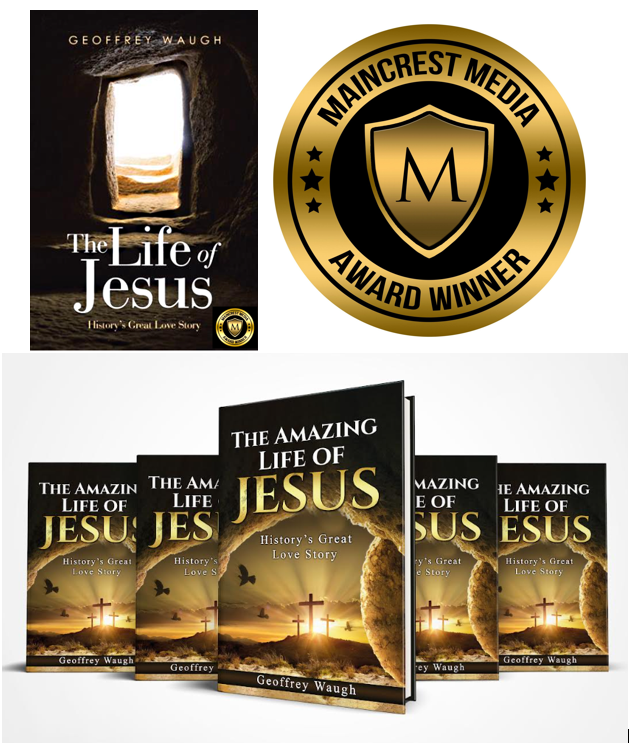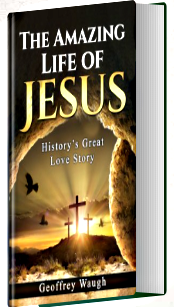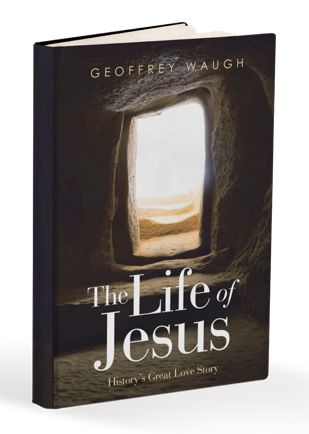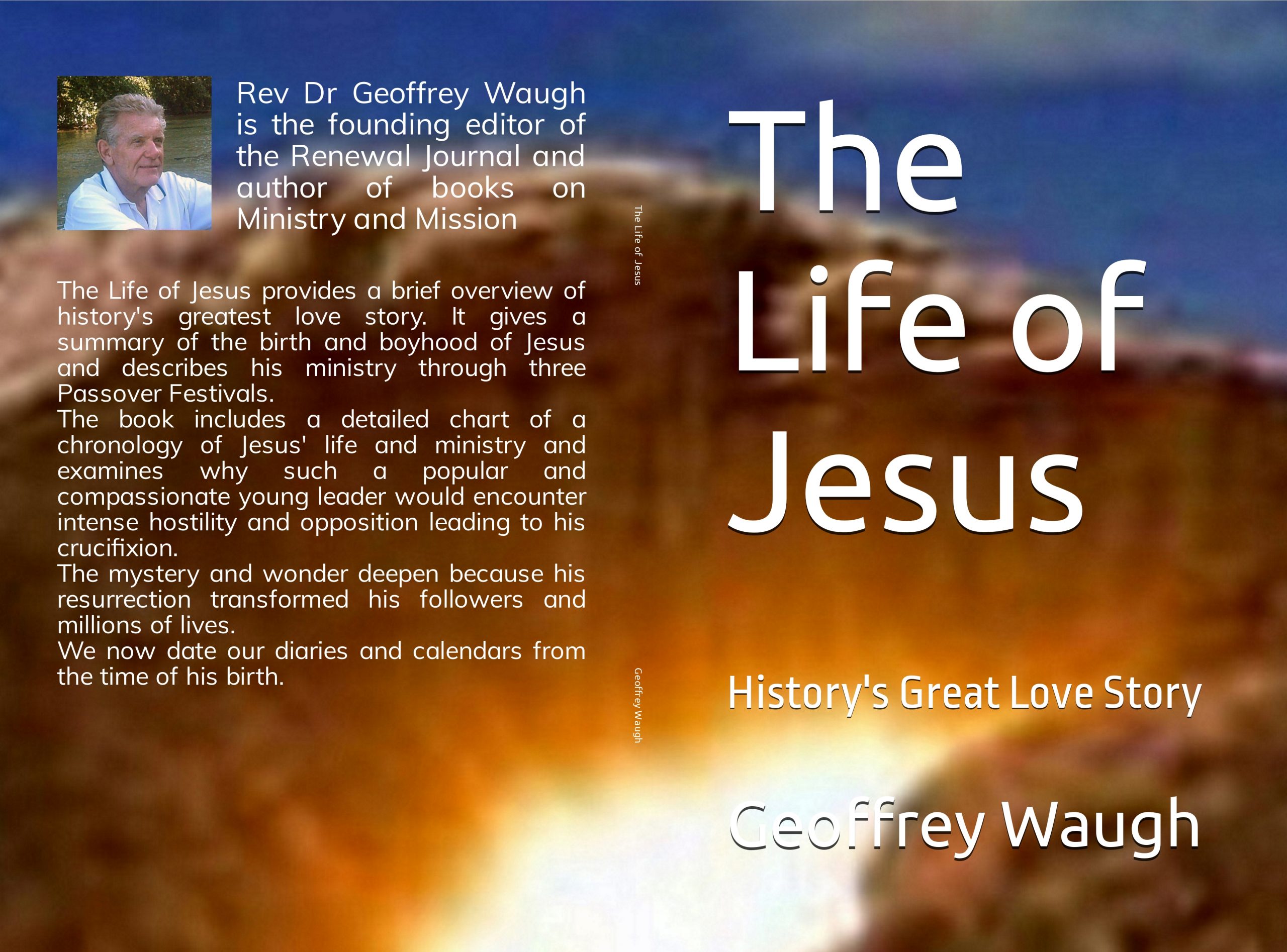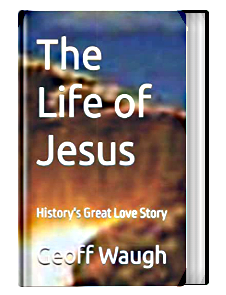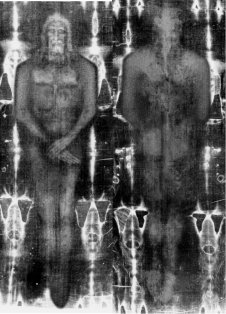The Amazing Life of Jesus – Geoffrey Waugh
Free PDF eBooks and inspiring blogs
Permission: you can freely reproduce and share these books and resources, including printing, just include the source
Renewal Journal Main Page – Free PDF books

The Amazing Life of Jesus – Blog
Free PDF eBook: The Amazing Life of Jesus
because his love changes lives forever
LIFE WAY Digital Magazine, cover story May 2025


The Amazing Life of Jesus, also available as
The Life of Jesus
Maincrest Media Award Winner 2024: The Life of Jesus


The Life of Jesus – Blog
The Life of Jesus – free PDF eBook
Available from Amazon and WestBow Press, a division of Thomas Nelson & Zondervan.
because his love changes lives forever
Review Endorsements (from social media)
* I must commend the exceptional quality of this work. The depth of insight, clarity of expression, and emotional resonance are truly remarkable. It’s rare to encounter a book that not only informs but also transforms its readers. The overwhelmingly positive feedback is well-deserved, and I join others in recommending this as a valuable and impactful read. Congratulations to the author on such an inspiring and masterfully written contribution. – Katty Jay
* Our team recently came across your book entitled The Life of Jesus: History’s Great Love Story, and we were captivated from start to finish. Your writing style is not only engaging but also remarkably insightful, and the story-line/topic you’ve crafted is nothing short of compelling. Its unique qualities and the emotions it evokes have the power to resonate with readers on a profound level. ~ James Mendez (Skylark)
* This is a very informative, amazing, and powerful book. Thanks to the author for investing hours of research, expressed with his masterful command of language. ~ Alex Johnson
* Be enriched. A most helpful telling of the life of Jesus using the biblical text and adding some background and charts. Anyone using this book will be enriched. ~ Rev Dr John Olley
* Geoffrey Waugh has written a very helpful devotional book about the Saviour of the world who is also the loving presence in believers. His use of chronology for headings and the many sub-headings makes the book simpler to absorb, even for an enquirer or new believer. I warmly commend this book. ~ Rev Dr Tony Cupit
* Impressive! This book is truly outstanding! Congratulations on this remarkable accomplishment. Keep up the exceptional work! ~ Rachael Diaz
* I had the pleasure of reading your book last night. It is truly exceptional, providing fresh insights. The Life of Jesus effectively directs readers to the profound and uplifting news about who Jesus is and the significance of his actions. Thank you so much for this blog site about Jesus’ Life. ~ Christiana Michael.
* A great read that gives a fresh and interesting perspective. Mel.
* This is a wonderful book and can be read over and over. Thank you. ~ Kerry Rawson
* I keep this book with my Bible. It is especially helpful when reading through the Gospels. ~ Cathy Hartwig
* This is a great read. Simple and easy language that even my children can read as a guide, and have a better understanding of the Life Journey of Christ, as they read it in the Gospels. Thank You. ~ Florence
* The book is beautifully written and I have learned and understood a lot. I am recommending this book. ~ Kattie Mayson
* I experienced enrichment through this profound portrayal of Jesus’s life. A compelling read with straightforward and accessible language. This remarkable book is a true gem, deserving to be revisited time and again. ~ Henry
* I was going through a tough time. This book saved my life! ~ Danielle Davis
* I have found this book to be extremely powerful and effective in my life. Highly recommended. ~ Eileen Marks
* A big life saver. I am very grateful to the author for writing this book. ~ Regina Cruz
* I really enjoyed reading this. It was quite inspirational and remarkable. What an epic journey! I look forward to reading more from this author in the future. ~ Alan Harlow
* A BIG thumbs up to the author for writing it. ~ Constance Morgan
* Your book cover looks fantastic! Your writing style is exceptional, and I loved how the story unfolded, keeping me captivated. ~ Solomon Emordi
* What a captivating cover! There’s such an art to capturing a story visually, and this one does it so well. Wishing you all the best with the release! ~ Habeeb Ayomide
* Beautiful cover art and a captivating title! Already hooked. Your book is fantastic! Sending you best wishes for its success. ~ Enny Precious
* I’m blown away by your book cover – it’s stunning! And the title is pure genius, it’s got me intrigued from the very start! ~ Jennifer Mary
* The concept sounds absolutely fascinating, and the cover art is stunning—it really draws you in! ~ Chamberlain Payne
* Your book looks amazing! Its potential to captivate readers is truly inspiring. ~ Shavon Thompson
* This is amazing. Your books are educational and captivating. It brings true memories and happiness. You’re such a brilliant book author, you truly have extensive knowledge of how to catch attention and engage the audience. ~ Patricia Donald
* The passion and dedication you’ve invested in every page are truly inspiring! Now that this exceptional book has come to fruition, what’s your vision for its next great milestone? ~ Ayo J. Olaniyi
* Offering fresh insights, The Life of Jesus points you to the great good news of who Jesus is and what he did. ~ Back cover
* I read your book last night. This is a great book. Thanks for writing this for all of us. ~ Nabeel Sharoon in Pakistan, translated it into five languages: Hindi, Indian Punjabi, Urdu, Sindhi, & Pakistani Punjabi.
Indian & Pakistani Translations – Blog
Urdu, Hindi & more translations
You can freely reproduce and print these PDF eBooks ![]()
because his love changes lives eternally
Renewal Journal Store

Free eBooks on this page. Paperbacks in Renewal Journal Store
Videos

Spotlight TV interview on The Life of Jesus
Free PDF eBook: The Amazing Life of Jesus
The Amazing Life of Jesus provides a brief overview of history’s great love story. It gives a summary of the birth and boyhood of Jesus and describes his ministry through three Passover Festivals.
The book includes a detailed chronology of Jesus’ life and ministry and examines why such a popular, loving, and compassionate young leader would encounter intense hostility and opposition causing his crucifixion.
The mystery and wonder deepen because his resurrection transformed his followers and millions of lives. We date our diaries and calendars from the time of his birth. His story is now the world’s best seller annually, translated into over 1400 different languages.
Also available in earlier versions as The Life of Jesus.

The Life of Jesus – WestBow Press – PDF
WestBow Press version – The Life of Jesus
Amazon – paperback, hardcover, Kindle
Koorong A$19.99: ![]()
because his love changes lives forever
Expanded PDF eBook version. Extra Bible passages are included in The Story of Jesus:

The Story of Jesus – Blog – expanded version
The Story of Jesus expanded PDF eBook
This PDF is an expanded version of The Life of Jesus with extra Bible passages included.
The same Contents and Chapters with more detail added.
Page 4 of the PDF lists some of the additional passages
An expanded version of The Life of Jesus
with extra biographical Bible passages added
Permission: you can freely reproduce and share these resources and books, including printing (just include the source). You can print, distribute, and market your edition of any of my books – “by all means save some” (1 Cor 9:22)
Share good news – Share this and any page freely. Over 150,000 blog views annually.
Share this link on your media, eg Facebook, Instagram, and Emails:
The Amazing Life of Jesus: History’s Great Love Story
also available as:
The Life of Jesus: History’s Great Love Story
Renewal Journal – a chronicle of renewal and revival: www.renewaljournal.com
Geoff Waugh – founding editor of the Renewal Journal
Free PDF books on the Main Page
Permissions: You can reproduce any Renewal Journal resource freely, including in print.
Contents
Preface [see below]
Introduction [see below]
1 Birth and Boyhood
2 Ministry Begins
3 First to Second Passovers
4 Second to Third Passovers
5 Passover to Pentecost
Conclusion
Discussion Questions [see below]
Appendix 1: Chronology Chart
Appendix 2: The Feast Days
Appendix 3: The Gospels
Appendix 4: Alternative Chronology
Appendix 5: The Shroud of Turin
Appendix 6: Publications
Other Translations
The Life of Jesus in Hindi, Indian Punjabi, Urdu, Sindhi, & Pakistani Punjabi.

The Story of Jesus: History’s Great Love Story – Blog in English
The Life of Jesus in English and Hindi – Blog
The Life of Jesus in Hindi & English Headings – PDF
The Life of Jesus in Indian Punjabi – Blog
The Life Of Jesus in Indian Punjabi & English Headings – PDF
The Life of Jesus in English and Urdu – Blog
The Life of Jesus in Urdu & English Headings – PDF
The Life of Jesus in English & Sindhi – Blog
The Life of Jesus in Sindhi & English Headings – PDF
The Life of Jesus in Pakistani Punjabi – Blog
The Life of Jesus in Pakistani Punjabi & English Headings– PDF
Preface
Why would such a good man who loved so profoundly and helped so many people be killed? Why did he provoke opposition?
If God walked among us in the person of his Son, why would people want to kill him? Why did so many vehemently oppose him?
That puzzled me as a boy. It still does.
The greatest love story the world has ever seen led to the excruciating death of crucifixion.
Many people have given their lives for other people as soldiers do in war. They die for others, defending home and country. But Jesus’ death was different. God’s Son chose to die for us because of his immense love for us. He took our place. His death gives us life. He is the perfect, sinless, eternal sacrifice for us. His blood cleanses us from all our sin as we trust in him. We are forgiven.
But why did so many good people, good religious people, hate him? That puzzled and fascinated me, so I explore that mystery in this book. I wanted to write a summary overview that people of all ages could read.
I always believed in Jesus. Even as a small boy I loved to hear and then read stories about him. He was so unique, so different. I believed his story as a boy and trusted in him. I still do and I hope you do too.
Jesus did what was good. He healed the sick, fed the hungry, set people free from addictions and evil, performed miracles, and even raised dead people. Huge crowds followed him and wanted him to be their king.
Now billions follow him, captivated by his love, the greatest love story of all. You can do that also. I invite you to simply pray something like this: Thank you Lord for all you’ve done. Forgive me for any wrong in my life. I trust in you and give my life to you.


Introduction
The year on our calendar or diary reminds us of when Jesus was born, approximately. We count the years from his arrival. So when you look at your diary or calendar you can be reminded again of Jesus.
They called him Yeshua (Joshua/Jesus) of Nazareth, the same name as Moses’ famous general who led God’s people into their Promised Land. Yeshua means God saves, or God is salvation.
That name comes to us in English through many translations from Yeshua or Y’shua in Hebrew and Aramaic, then translated into Iesous in Greek, then to IESVS in Latin and later as IESUS as printed in the first edition of the King James Bible in 1611. Later that century ‘J’ replaced the ‘I’ so the English name became Jesu (vocative) and Jesus (nominative) but eventually just Jesus in English. Other languages have translations such as Jesu, Yesu, and Isa.
English translations of the Bible used the name Jesus for Joshua/Jesus of Nazareth, and the name Joshua for others with that same name.[1] So in English, the name Jesus became unique and sacred for Jesus of Nazareth, the Son of God, the Saviour of the world. The angel Gabriel announced his name before his birth to both Mary his mother and to Joseph who married Mary.[2] Gabriel explained that Yeshua (Joshua/Jesus) had that name because he would save his people from their sins.
The great love story had begun. Jesus came to save us and give us eternal life.
His followers recorded that story of his life and his love in the good news of the four Gospels: Matthew, Mark, Luke, and John. The rest of the New Testament explores the mystery and wonder of that amazing life and love.
Scholars have a bewildering array of theories about the Bible and about who wrote what, and when, and where, and why. I’m content to run with traditional explanations that have been used throughout most of history.
Jesus’ unique and wonderful life, his brutal death for us, and his powerful resurrection, all reveal his and God’s eternal love for us all. You could pause and thank him right now even as you read this.
John’s Gospel emphasizes God’s eternal love revealed in Jesus. It includes the most famous passage in the Bible:
For God so loved the world that He gave His only begotten Son, that whoever believes in Him should not perish but have everlasting life.
For God did not send His Son into the world to condemn the world, but that the world through Him might be saved. (John 3:16-17, NKJV).
That love, powerfully shown on the cross, has transformed billions of lives, restoring believers to an intimate and eternal relationship with God and with others.
Three physical metaphors help me to be constantly aware of, and grateful for, God’s presence with us always:
(1) Light surrounds you. By it you can read this. The sun always shines, even when it’s hidden from us. Light shines around us though we may be unaware of it. God is light and in him there is no darkness at all. We can live in his light.
(2) Blood pumps through your body right now, cleansing and healing. We may be unaware of it until reactions like alarm alert us to our beating heart. Jesus’ blood cleanses from all sin, always. We can trust him for he is with us.
(3) We may breathe without being aware of it, or we can be aware and take deep breaths, as you may have done just now! Breath purifies our lungs and body. God is Spirit and like breath or fresh breeze, he can purify us.
May the light of God’s love breathe life in you right now.
We’ve been made in God’s image to have an eternal, loving relationship with him that even transcends death. We can know and experience God’s unconditional love no matter how far we stray from him. Those who stray most are often the most grateful for his forgiveness and love. We all stray in many ways and we all need forgiveness and we can and should be truly grateful.
God knows and loves us as we are. That makes praying or talking to him easy because he already knows our failures and struggles and welcomes us just as we are. The more honestly we come to him the more he can transform us.
If we have trouble believing we can at least say, “God, if you’re there, help me.”
Some thoughts may get in the way when we pray or want to talk to God. Just give him those thoughts. He already knows all about it and loves us as we are.
If we reject God’s love and mercy by ignoring him and going our own way, we condemn ourselves to eternal darkness away from his light and love.
If we accept his love and forgiveness by believing in him, by trusting him, he gives us life, his eternal life. That makes us new. We are transformed.
Vast numbers of people worldwide of all faiths, and of none, have prayed the prayer in the popular hymn by Charlotte Elliot, ‘Just as I am’ which includes these adapted verses:
Just as I am, without one plea
But that Your blood was shed for me
And that You bid me come to Thee,
O Lamb of God, I come, I come.
Just as I am, though tossed about
With many a conflict, many a doubt,
Fighting and fears within, without,
O Lamb of God, I come, I come.
God welcomes us and we can all pray that prayer. A title for Jesus, as in that song, is the sacrificial Lamb of God who takes away our sin.
The Life of Jesus is a vast topic with millions of books written about it. I hope my small contribution gives you a helpful overview. I quote from the New Revised Standard Version unless indicated otherwise, and include many footnotes that you can explore to discover more.
Best of all, of course, are the inspired Gospels now in over 700 different languages in Bible translations and a further 3,500 languages have Bible portions, especially the Gospels. Read and respond to those Gospels.
[1] Iesous (Yeshua) is translated as Joshua in these verses: Luke 3:29; Acts 7:45; Hebrews 4:8.
[2] Luke 1:31; Matthew 1:21.


Start of Chapter 1
It began at the beginning, this great love story, for “In the beginning God created the heavens and the earth.”[1]
Why did he do that? For us.
He did it for you. He loved you so much he created you to know and enjoy him now as you read this, and forever. He offers you intimate, infinite love. He created you through the wondrous union of your parents’ ecstasy.
He made the earth for us to inhabit and care for and rule. He made the heavens (plural) for us to inherit, the physical firmament and also the realms of vast, eternal glory prepared especially for us.[2]
He created us free to accept or reject his astounding love. Sadly we went our own way. We all, like sheep, went astray. We all turned to our own way. So God laid on his Servant, his Son, all our iniquity.[3] God saves us through his Son in their great love for us all. You could pause and thank him now as you read this.
In the beginning, Adam and Eve enjoyed intimate, unashamed relationship with God and each other. Then, like us, they believed lies and went their own way, losing Paradise. But God still blessed and sustained them and their descendants who chose to love him and live for him. Sadly only a few did.
Noah and his family loved and obeyed God and he rescued them from the great flood. People ridiculed him for obeying God and building a huge boat on dry ground – not even in a dry dock. The rainbow became the sign of God’s covenant to Noah and his descendants including us.
Abram, a wealthy sheik from the wide fertile Tigris and Euphrates valleys in western Asia, north-west of the Arabian Peninsula (now Iraq), loved and obeyed God. Renamed Abraham (God’s friend) he journeyed to the Promised Land, now called Israel, from the name given to his grandson who wrestled with an angel or with the Lord.[4] Circumcision became the covenant sign for them and for their descendants through whom God would provide his salvation for us all.
Abraham and his descendants walked that verdant Promised Land, as did Jesus and his followers. So did our family for a month in December-January, 1981-82.[5]
King David reigned there for 40 years from around 1000 BC, described as a man after God’s own heart who would do what God wanted.[6] That’s an amazing picture of God’s love and grace for flawed people like David. His descendants ruled from his capital, Jerusalem, till the fall of their kingdom to Babylon. The human Jesus was descended from David through Mary, as was Mary’s husband Joseph, also a descendant of the royal line of David.
God blessed his people through history when they remained faithful to him but sadly, like us, they often went their own way, not God’s way. The northern kingdom of Israel fell captive to Assyria by 722 BC, as did the southern kingdom of Judah to Babylon from 597 BC. Then Cyrus of Persia allowed the exiles in captivity to return from 538 BC. Babylonian armies took captives in waves of exiles, and the exiles returned in various groups, then speaking Aramaic, a Semitic language similar to their Hebrew Scriptures. Their temple in Jerusalem lay in ruins for 70 years, from 586 BC to 516 BC. The returning exiles became known as Jews, a term derived from the former kingdom of Judah.
Alexander the Great’s conquests established Greek culture and language in Israel from around 333 BC, eventually sparking the Maccabean revolt from 165 BC with the Jews gaining independence from 134 BC.
Their independence lasted less than a century till 63 BC when warring brothers appealed to Rome, and Roman armies then invaded and killed 12,000 people, including temple priests, in the siege of Jerusalem. Rome then ruled its province of Judea, also named from the previous kingdom of Judah.
Those searing memories simmered strong in the Israel of Jesus’ day when Jews longed for their Messiah to deliver them. Radicals often attacked the Roman occupying armies. Rome retaliated swiftly and brutally. Their armies slaughtered thousands, with hundreds nailed to crosses as in a rebellion led by Judas the Galilean in AD 6 when Jesus was a boy.[7]
Jesus’ elderly relatives the old priest Zechariah and his wife Elizabeth lived near Jerusalem, and Zechariah had been literally dumfounded while offering incense in the temple during his roster when the angel Gabriel told him they would have a son to be named John. Zechariah spoke again nine months later at his son’s birth when he announced that the boy’s name was John.[8]
Six months after that temple encounter, Gabriel appeared again, this time to Mary in the northern hills of Nazareth. He announced that Mary would conceive by the Holy Spirit and her son would be called Yeshua (Joshua/Jesus), meaning ‘God saves’ or ‘God is salvation.’
Mary’s pregnancy created a problem for her espoused husband-to-be Joseph. Being a good man he decided to separate or divorce quietly and not make a fuss now Mary was pregnant. An angel intervened in a dream and explained about the miraculous pregnancy and that Mary’s son would be named Yeshua (Joshua/Jesus) because he would save his people from their sins. Matthew wrote that it fulfilled Isaiah’s prophecy:
‘Look, the virgin shall conceive and bear a son,
and they shall name him Emmanuel’
which means, ‘God is with us.’ (Matthew 1:23; Isaiah 9:6)
The great love story burst into history through that holy, miraculous conception. Excited at her news, Mary journeyed about 100km (64 miles) south to visit her relatives Elizabeth and Zechariah near Jerusalem. Old Elizabeth declared that her baby John leaped in her womb when she heard Mary’s news.[9] Mary stayed with Elizabeth and her dumb husband for three months till John was born (when Zechariah spoke again). They believed Gabriel’s word that John would, in the spirit of Elijah, announce the coming of the Lord. Those two women, supernaturally blessed, carried the wonder of God’s loving purposes in their wombs.
This came in the fullness of time.[10] Previous history pointed to Jesus’ coming as the Messiah, the Christ, God’s Son. We now date history from that birth.
[1] Genesis 1:1.
[2] John 14:1-6; 1 Corinthians 2:9.
[3] Isaiah 53:6. See Isaiah 52:13-53:12, the fourth Servant Song, along with Isaiah 42:1-4; 49:1-6; 50:4-7.
[4] Genesis 17:5; 32:28; 35:9-10.
[5] See Exploring Israel in General Books and Biography on renewaljournal.com
[6] 1 Samuel 13:13-14; Acts 13:22
[7] Acts 5:36-37.
[8] Luke 1:5-24.
[9] Luke 1:26-45.
[10] Galatians 4:4; Ephesians 1:10.
Conclusion
The life of Jesus is history’s great love story. The overview in this brief book points you to the great good news of who Jesus is and what he did. That story is told best in the Bible, God’s inspired word.
I hope this brief commentary points you again to that God-breathed living word. It gave me fresh insights as I researched the harmonized story of these gospels.
Many writers discuss the popular five love languages: affirmation, service, gifts, time, and touch. Jesus demonstrated all these in various ways.
He affirmed and admired faith, especially faith in him for healing and help.
He served daily and showed it dramatically by washing his disciples’ feet.
He gave his life for us and ultimately he gives eternal life to all who believe.
His three years of quality time with his followers prepared them to serve.
His touch brought physical and spiritual healing and freedom to multitudes.
I love the way John summed up the reason for writing his Gospel: “Now Jesus did many other signs in the presence of his disciples, which are not written in this book. But these are written so that you may come to believe that Jesus is the Messiah, the Son of God, and that through believing you may have life in his name.” (John 20:31)
That is my prayer for you, my reader. Here is my echoing sonnet, penned over fifty years ago.
Sin stalks the soul, and permeates the whole
Of life lived here where we, while bound by fear,
Hunt far and near for freedom to appear
From pole to pole with our minds in control.
That worthy goal seems mockery. Sin stole
Our freedom dear, left pain and woe to sear
Each life, a mere heartache, or sob, or tear,
Like a lost mole, blind, dirty in its hole.
God’s love stepped in to fight and conquer sin
Through Christ who bled and died and rose as Head
Supreme of all who claim Him Lord. Our fall,
Clamour and din may end in Him. We win
Release from dread, freedom, life from the dead,
Unbound from gall, in answer to His call.

Map in the book

See also Devotional Books

(7) The Lion of Judah – Blog
The Lion of Judah – PDF
6 books in one volume
* Looking for a great book to help you meditate on the wonder of Jesus in all his richness and grandeur and love? Geoff Waugh has helpfully and thoughtfully brought together wide-ranging biblical passages… Read this book prayerfully and you will not be the same! ~ John Olley.
* This book is full of information, biblical information. I have learned so much from it … If you want to learn more from the Bible, this is the book to read. ~ A. Aldridge
 *
*
Crucified and Risen – Blog
Crucified & Risen – PDF
The Easter Story

Holy Week, Christian Passover & Resurrection – Blog
Holy Week, Christian Passover & Resurrection – PDF
3 books in 1

Christian Passover Service – Blog
Christian Passover Service – PDF
A Retelling of the Last Supper

RISEN: long version – Blog
Risen! –_PDF
12 resurrection appearances

Mysterious Month – Blog
Mysterious Month – PDF
Jesus’ resurrection appearances & our month in Israel

Kingdom Life in The Gospels – Blog
Kingdom Life in The Gospels – PDF
4 books in 1
Popular Books – by Geoff Waugh
Revival Books – gift ideas
Renewal Books – gift ideas
General Books – gift ideas
Devotional Books – gift ideas
GENERAL BLOGS INDEX
Blogs Index 1: Revivals (briefer than Revivals Index)
Blogs Index 2: Mission (international stories)
Blogs Index 3: Miracles (supernatural events)
Blogs Index 4: Devotional (including Testimonies)
Blogs index 5: Church (Christianity in action)
Blogs Index 6: Chapters (Blogs from Books)
Blogs Index 7: Images (Photos & Videos)
Share any Blog to inform and bless others

Click here to be notified of new Blogs
Share good news – Share this page freely
Copy and share this link on your media, eg Facebook, Instagram, Emails:
The Amazing Life of Jesus: History’s Great Love Story
Renewal Journal – a chronicle of renewal and revival:
www.renewaljournal.com

